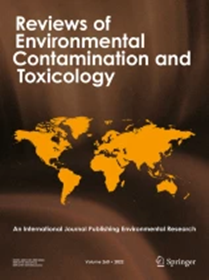双氯芬酸光降解研究:机理、效率、参数作用、毒性评价和催化剂稳定性
IF 6.6
3区 环境科学与生态学
Q1 ENVIRONMENTAL SCIENCES
Reviews of environmental contamination and toxicology
Pub Date : 2023-11-11
DOI:10.1007/s44169-023-00052-y
引用次数: 0
摘要
药品和个人护理产品(PPCPs)是新兴的污染物(EPs)之一,随着其需求量的增加而引起了环保人士的关注。双氯芬酸(DFC)是一种抗炎药物,用于治疗疼痛的一线治疗。大约15%的DFC在人类食用后未被代谢,从而增加了将DFC释放到环境中的机会。随着时间的推移,DFC可能会在环境中积累,从而增加其对生态系统的负面影响。几种生物、物理和化学技术已被应用于处理DFC。本文综述了DFC的光降解研究进展,包括光降解效率、机理、理化参数的作用以及毒性评价。总的来说,光降解系统的去除率很高。然而,每个实验都是在不同的实验条件和不同的参数下进行的,如催化剂的类型和用量、选择的辐射波长、pH、温度和添加剂浓度。这导致了DFC在光降解效率和光降解速率上的差异。我们发现光催化过程的理化参数是一把双刃剑。一方面,将它们的值提高到一定程度可能有助于治疗效果良好。另一方面,大幅上升会对治疗效果产生负面影响,并增加治疗操作的费用。毒性试验表明,最常见的DFC副产品是不安全的,它们释放到环境中可能对生态系统产生负面影响。本文综述可为今后希望通过光降解处理DFC的研究人员提供有益的建议,并使他们能够提高光降解的适用性。本文章由计算机程序翻译,如有差异,请以英文原文为准。
Insight into Photodegradation of Diclofenac: Mechanism, Efficiency, Role of Parameters, Toxicity Assessment and Catalyst Stability
Pharmaceuticals and personal care products (PPCPs) are one of the emerging pollutants (EPs) groups that attracted the environmentalist’s attention according to the increase in their demand. Diclofenac (DFC) is an anti-inflammatory medication used as a first-line treatment for pain. Around 15% of DFC is unmetabolized after human consumption, leading to an increase in the opportunity to release DFC into the environment. DFC may build up in the environment over time, which increases its negative impacts on the ecosystem. Several biological, physical, and chemical techniques have been applied to treat DFC. This review provides an overview of the photodegradation of DFC including photodegradation efficiency, mechanism, the role of physicochemical parameters, and toxicity assessment. Generally, the photodegradation systems showed high efficiency in the removal. However, each experiment has been applied under different experimental conditions and different parameters such as the type and dosage of catalyst, the chosen wavelength of the radiation, pH, temperature, and additive concentration. This led to the differentiation in the photodegradation efficiency and photodegradation rate of DFC. We revealed that the physicochemical parameters of the photocatalytic process are a double edge sword. On the one hand, raising their values up to a certain point might help the treatment work well. On the other hand, a significant rise has a negative impact on the effectiveness of the treatment and raises the expense of the treatment operation. The toxicity tests indicated that most frequent DFC by-products are not safe, and their release into the environment may negatively affect the ecosystem. This review may provide a useful recommendation for future researchers who want to treat DFC by photodegradation and enables them to enhance the applicability of photodegradation.
求助全文
通过发布文献求助,成功后即可免费获取论文全文。
去求助
来源期刊
CiteScore
12.80
自引率
0.00%
发文量
11
审稿时长
>24 weeks
期刊介绍:
Reviews of Environmental Contamination and Toxicology publishes reviews pertaining to the sources, transport, fate and effects of contaminants in the environment. The journal provides a place for the publication of critical reviews of the current knowledge and understanding of environmental sciences in order to provide insight into contaminant pathways, fate and behavior in environmental compartments and the possible consequences of their presence, with multidisciplinary contributions from the fields of analytical chemistry, biochemistry, biology, ecology, molecular and cellular biology (in an environmental context), and human, wildlife and environmental toxicology.
•Standing on a 55+ year history of publishing environmental toxicology reviews
•Now publishing in journal format boasting rigorous review and expanded editorial board
•Publishing home for extensive environmental reviews dealing with sources, transport, fate and effect of contaminants
•Through Springer Compact agreements, authors from participating institutions can publish Open Choice at no cost to the authors

 求助内容:
求助内容: 应助结果提醒方式:
应助结果提醒方式:


